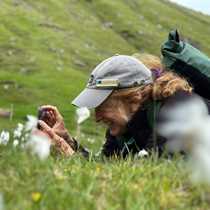We started our remarkable journey this morning before the sun rose above the horizon. In the light of a quarter moon and a bit more sparkle added by a setting Venus, we boarded boats, headed west and found the shore. A small group of us greeted sunrise with the foreground element of our ship in silhouette and a backdrop of early morning persimmon skies. As the dawn slowly revealed the waking world, we returned to the mother ship National Geographic Sea Bird to finish waking up as well.
Fortified by a satisfying breakfast we returned to Isla Magdalena and started our walks. Soft flour sands massaged our toes and our souls as we walked across the wasp waist narrow of the island. We listened to the piping of willets as they took flight in an unprovoked panic. The horned larks perched atop the sculpted dunes were the wind chimes of the morning, calling in a delicate liquid-tinkling sound.
Delicate mouse tracks wove through the protective shelter of sea purslane, iodine bush, and sand verbena hummocks. On the Pacific side of the island we found tun shells, long washed ashore, ornamented with bubblegum pink expired barnacles. Bones of sea lions, pelicans, sea turtles, and piles of sun bleached sand dollars tossed ashore by the surf of the Pacific Ocean all vied for our attentions.
We took on our pilot and navigated through the waters of Canal de Soledad. Sightings of white ibis, tricolored heron, royal terns, and western gulls were recorded along with the requisite frigates soaring above and an obligatory backdrop of pelicans resting and preening on narrowing sandbars.
Our day ended with the sighting of two different marine mammals; ephemeral ghosts that would fully reveal themselves to be bottlenose dolphins when they rose from the murky green waters for a quick exhale and inhale and gray whales. Cow/calf pairs of gray whales were sighted near and far. From the protected waters created by the barrier islands of Isla Magdalena and Santo Domingo and in the churning waters where the tidal emptying of the bay crashed into a surging Pacific Ocean. These animals will soon be leaving the bay, ultimately for rich feeding grounds in the Bering and Chukchi Seas. But for now, they are here and so are we, a boatload of admiring fans waiting to meet and greet the Baja California gray whales.







